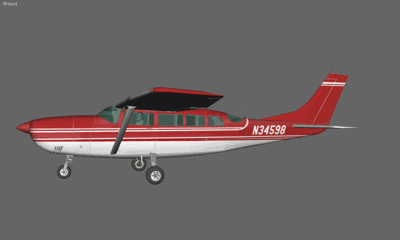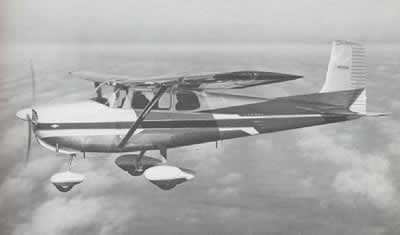One Person Fatally Injured As A Result Of The Accident
The NTSB has released its preliminary report from a mid-air collision accident between a Cessna 175 and a Cessna 206 near the mouth of the Big Susitna River, about 20 miles west of Anchorage, Alaska. The Cessna 207 was being operated as Flight 38 by Spernak Airways, Inc., Anchorage, as a visual flight rules (VFR) scheduled commuter flight. The Cessna 175 was registered to and operated by the pilot as a VFR personal flight.

The commercial pilot of the Cessna 207 was fatally injured. The private pilot of the Cessna 175 was not injured. Visual meteorological conditions prevailed in the area at the time of the accident. The Cessna 175 departed a remote fish camp about 1126 AKD en route to the Lake Hood Seaplane Base (PALH) with no flight plan filed. The Cessna 207 departed Merrill Field (PAMR), Anchorage, about 1200 with about 250 pounds of cargo on board, destined for Tyonek (TYE), Alaska, with company flight following procedures in effect.
During an interview with the National Transportation Safety Board (NTSB) investigator-in-charge (IIC) on June 14, the pilot of the Cessna 175 stated that while in level cruise flight at an altitude of about 1,000 feet (ft) above mean sea level (msl), he began talking on the radio with the pilot of a Piper Super Cub, which was passing in the opposite direction, to maintain visual separation. He added that, as he watched the Piper Super Cub pass well below his airplane, he noticed the shadow of an opposite direction airplane converging with the shadow of his airplane. Alarmed, he looked forward and saw the spinner of a converging airplane in his windscreen, and he said that he immediately pulled aft on the control yoke. The pilot said that his airplane climbed abruptly just before the two airplanes collided. After the collision, the Cessna 207 descended uncontrolled into the Big Susitna River. He said that, after the collision, he assessed the condition of his airplane and circled over the wreckage of
the downed Cessna 207 numerous times, looking for any survivors, marking the location, and using his radio to enlist the help of any pilots in the area. Realizing that no one had escaped the partially sunken wreckage of the Cessna 207, the pilot elected to return to PALH. He said that a Good Samaritan pilot in an airplane responded to his distress calls, flew alongside his damaged airplane, provided him with a damage report, and escorted him back to PALH.
A second Good Samaritan pilot in a float-equipped airplane heard multiple distress calls and emergency personnel communications, landed on the river near the partially submerged wreckage, and confirmed that the pilot was deceased.

The Cessna 175 pilot subsequently made an emergency landing on Runway 32 at PALH, a 2,200-ft-long, gravel-covered runway. Two NTSB investigators responded to PALH, talked with the Cessna 175 pilot, and examined the wreckage. The Cessna 175's left main landing gear and nosewheel were separated and missing. The right main landing gear tire was cut with features consistent with a propeller strike, and the outboard portion of the right elevator sustained impact damage with red paint transfer. The airplane sustained substantial damage to the fuselage and right elevator.
Due to the location of the wreckage of the Cessna 207 in the silt-laden waters of the Big Susitna River, the NTSB IIC was unable to examine the wreckage at the accident site. An aerial survey of the accident site, which was conducted from an Alaska State Troopers' helicopter, revealed that the wreckage was inverted and partially submerged near the mouth of the river. The left main tire and a portion of the fuselage were protruding from the water. The Cessna 175's left main gear leg with the wheel attached, as well as other wreckage debris, was found on the east bank of the river about 1,380 ft east of the Cessna 207's main wreckage.
A preliminary review of archived FAA radar data revealed that, on June 13, about 1203 AKD, two unidentified targets, believed to be the accident airplanes, converged from opposite directions about 1,000 ft msl near the mouth of the river. The data showed that, about 1 minute before the presumed accident time, the westbound target, believed to be the Cessna 207, began a descent to about 874 ft msl then initiated a climb to an altitude of about 900 ft msl just before the targets appeared to merge. That airplane's track disappeared about 1205 AKD. The eastbound target, believed to be the Cessna 175, maintained an altitude of about 1,000 ft msl throughout the sequence. After the targets appeared to merge, the eastbound airplane initiated a climb, returned to the area near where the targets converged, and circled for some time before leaving the area.
The closest weather reporting facility was at Anchorage International Airport (PANC), Anchorage, Alaska, about 20 miles east of the accident site. At 1153, a METAR from PANC reported, in part: wind from 290° at 5 knots; visibility, 10 statute miles; clouds and sky condition, few clouds at 4,500 ft, few clouds at 10,000 ft, scattered clouds at 20,000 ft; temperature, 55° F; dew point 43° F; altimeter, 29.91 inches of mercury.
A detailed wreckage examination is pending following recovery.
(Images from file. Not accident airplanes)
 Unfortunate... ANN/SportPlane Resource Guide Adds To Cautionary Advisories
Unfortunate... ANN/SportPlane Resource Guide Adds To Cautionary Advisories ANN FAQ: Turn On Post Notifications
ANN FAQ: Turn On Post Notifications ANN's Daily Aero-Term (04.29.24): Visual Approach Slope Indicator (VASI)
ANN's Daily Aero-Term (04.29.24): Visual Approach Slope Indicator (VASI) ANN's Daily Aero-Term (04.28.24): Airport Marking Aids
ANN's Daily Aero-Term (04.28.24): Airport Marking Aids ANN's Daily Aero-Linx (04.28.24)
ANN's Daily Aero-Linx (04.28.24)




